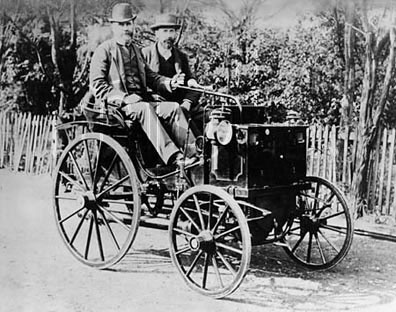It wasn’t long after the fist cars were designed and built that drivers were in competition as to who had the fastest car, or who could go the furthest. In fact the first races were in France at the end of the nineteenth century and involved 21 cars in a race from Paris to a town called Rouen and back to Paris again. It was a 750 mile race along poorly constructed roads, as mainstream cars were still not a popular sight on the so-called roads of the time.

Don’t forget, the roads were constructed for horses and carts and not motor vehicles for some tens of years after that. The race was officially won by Paul Koechlin in a four-seater Peugeot at 59 hours and 48 minutes; but Frenchman, Émile Levassor, who completed the journey in 48 hours and 48 minutes driving a two-seater car, was the first to cross the finish line in his self-built Panhard et Levassor.
As Seen on TV
Or at least the racing circuit. As expected, the news travelled the world over and motor racing events were held all over the continent; even America, who by now, were enthralled by the motor car age. It became obvious over the following years that winning races was great publicity for the manufacturers and would clearly sell more cars. In fact, in time, manufacturers of other products and services realised that by placing advertisements on these cars it gave their businesses a great deal of exposure, not only on the racing curcuit, but to the general public as well. This is why we see so many adverts on Formula one cars.
The first major advertiser on these early motor cars was a rich newspaper owner from America called Gordon Bennett. He actually arranged the road races in the early 1900’s with the sole purpose to advertise his newspapers in America even though the races were held in France; as the American public loved to read about foreign affairs and so it increased his sales.
Up until 1907, motor racing was banned in Britain as it was deemed to be unsafe to race on the public highway. A wealthy English businessman realised the potential of motor racing and decided to build an oval circuit on his own land in Brooklands in Surrey. He employed a huge team of workers and within the year has constructed the first track designed purely for racing cars which is still famous today.
The Brooklands racing circuit paved the way for more and more countries to start becoming involved in professional racing. Indianapolis built the famous oval circuit just 2 years later and venues in Italy, Spain and Germany followed soon afterwards.
It naturally evolved that as the these tracks were purposefully built, and were a much better surface for the cars to race, the cars became faster and more powerful. By the late 1930’s, racing cars were so quick that they were capable of almost 200mph. Obviously, the second world war made racing impossible. Shortly after, however, the FIA and Formula One was established with new rules and regulation for the sport. Just 3 years after this event, the first proper drivers championship was initiated.
Since this time, Formula One racing has largely remained unchanged in terms of how the system works however there have been many developments in terms of safety. In the 1950’s, for example, there were 15 fatalities in Formula One and 12 drivers lost their lives in the 1960’s. Developments in protective racing overalls and helmets, as well as changes to track layouts have meant that, thankfully, there have been no fatal accidents for nearly 20 years. Let’s hope it remains that way as the F1 series is the most exciting motor racing in the world watched by more than 500 million people.
Citations:
- Image Source
Guest post provided by theprivateplateco.co.uk. At the Private Plate Company, we are pleased to make available to you, the largest selection of personalised and DVLA number plates in the UK. Select your car number plate from our huge collection of customer commissions, personal stock, and former DVLA registrations.

